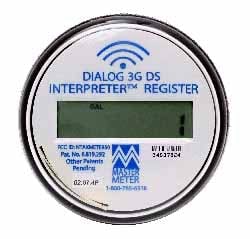When the city of Ottawa, Ontario, Canada set out to further tighten its grip on its water supply, the team assigned to the task felt it was time to take a fresh look at the way water utilities monitor for distribution system leaks and background water loss. Project engineers developed a pilot program using innovative automatic meter reading (AMR) technology to enhance and quantify data gleaned from district metering areas.
Ottawa’s Public Works and Services Department hopes the new AMR pilot program, the first of its kind in the city, will provide valuable insight into local water consumption patterns and establish guidelines that can be applied to monitoring non-AMR equipped district metering areas in Ottawa.
The city’s utility services branch of the Department of Public Works initiated the AMR pilot program. Responsible for the city’s water loss and leak detection efforts, the branch was looking to improve upon their ability to monitor leaks within the water distribution system. The city’s drinking water services and the customer services division within the utility services branch worked together through implementation.
Leaks that occur at the point of consumption (e.g. at a business or residence) are easier to catch than distribution system leaks. If a business or residence meter reports continuous flow, it provides ready indication of a problem. The water distribution system, however, always reports continuous flow in supplying water to the city. Utilities must take additional measures to detect unusual flows, which can indicate leaks in the system.
District metered areas (DMA) have become the preferred standard for proactive distribution system leak detection. A DMA consists of an isolated water distribution zone behind a single metered inlet or, in some cases, multiple metered inlets. The objective of the DMA is to measure the total volume of water flowing into the zone, and to compare that volume against legitimate water consumption within the zone. Subtracting legitimate consumption from the total flow into the zone provides the exact real loss within the distribution system.
Night flows and legitimate use
Utilities establish normal flow ranges for a given DMA by monitoring night flows, typically between 2 a.m. and 4 a.m. Monitoring night flows within DMAs has proven effective in helping to identify unreported bursts and other significant losses; however, Ottawa officials felt the process relied too heavily on assumptions of legitimate use to provide accurate numbers related to real losses.
The city’s project engineers created a design for their pilot system that would help clearly define real losses by measuring actual consumption at every metered point in the DMA. Subtracting confirmed metered use from the total flow metered entering the zone would provide exact indication of leakage in the distribution system.
The pilot project
Ottawa engineers began developing their pilot plan in early 2006. Engineers hoped to use the system to generate daily consumption patterns, identify effects of implemented water efficiency measure and test the reliability of meters. They felt confident that they could develop an AMR system capable of measuring actual night consumption with definitive accuracy.
Master Meter was selected to provide the AMR read technology. The company’s DIALOG 3G meters and registers incorporate a real-time clock capable of providing synchronized reads at distinct time steps. This was critical for the proposed system to capture nighttime usage consumption. The pilot project required an AMR upgrade for dozens of large meters operating within the system. Rather than replace the entire meter, Ottawa was able to replace the original registers on the large meters with Master Meter's universal AMR register, the Interpreter. The ability to retrofit existing infrastructure represented a significant savings in both the time and costs required for the AMR rollout.
Project rollout
The rollout for the pilot program began in the spring of 2007. Prior to the pilot program, all properties within the zone were fitted with standard billing water meters. Reads were collected from exterior mounted touch pads. During the AMR rollout, these meters were either replaced or upgraded with 3G meters and registers. The new meters can be read quickly and remotely by a passing utility vehicle fitted with a small wireless transceiver.
To enable night flow consumption testing, the real time clock in each register was set to record reads at 2 a.m. and 4 a.m. Synchronized readings are required for the accurate measure of consumption within the two-hour testing period. The resulting reads provide accurate measure of all of the flow into the zone and customer consumption within the two-hour testing period.
The AMR pilot project rollout in Ottawa is complete and the city is currently undergoing night flow testing, establishing usage patterns and evaluating all the new data being captured. In accordance with the overall project goals, it is looking to the AMR system to help establish daily consumption patterns, and to identify the effects of water efficiency measures being implemented.
Ottawa officials suggest that cities looking to implement similar AMR programs should pay very careful consideration to the type of system they require. When working with an AMR equipment provider, know what you want the system to do and make sure you ask for it. Ottawa project engineers suggest that, in many cases, the features you may be looking for may only incrementally increase the cost of a basic AMR system. By working with your AMR equipment provider, you can build and adapt a system specific to your needs.


